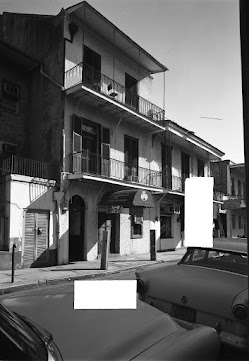 |
| November 2023 |
I think it may be safe to say that there are fewer places in New Orleans that AREN'T haunted than there are those that have reported some level of paranormal or unexplained activity. Seriously, there is no shortage of spooky happenings around the Crescent City, and the French Quarter is especially prone to tales of ghosts, goblins, and vampires.
Although my interests in visiting New Orleans are mainly for the ghosts, there's no denying that this is a party city year-round, but especially during this time of year as we approach Mardi Gras. In fact, the only thing New Orleans may have more of than ghosts is bars. Bourbon and surrounding streets are filled with places to get a Hurricane, Hand Grenade, or one of many, many other beverages to drink on-site or take with you. And, to no one's surprise, most of these bars are believed to be haunted! Haunted pub tours take visitors to some of the best-known haunted bars, but there's one location that stuck out to me on our recent trip.
Unfortunately, it has been closed for some time, and now sits vacant, but directly across from our hotel on St. Philip Street was the former Flanagan's...known before that as the Morgue Bar and Lounge.
Located at 625 St. Philip Street, the old Morgue Bar and Lounge is part of a larger building, subdivided by address. From what I can gather, it was built in the 1840's by Jean (John) Gleises, a wagon-wheel maker born in France. It was while the Gleises family owned the home that perhaps its darkest times would befall the Creole townhouse. During the summer of 1853, a particularly nasty yellow fever epidemic hit the New Orleans area. Those who had the money to spend the warm summer months in a more hospital climate did so. However, 50,000 residents of New Orleans would have no means of escaping the city. In a span of only 3-4 weeks, 10,000 of them would die from the dreaded disease.
 |
| 1960's |
This overwhelming amount of death required increased space for the bodies, and homes throughout the French Quarter and beyond were opened up as makeshift morgues. That was the fate of the Gleises residence. Not only were the bodies of yellow fever victims stored here, but those dying from other causes as well. Unfortunately, Jean wouldn't live to see the end of the year either, and died on September 4, 1853.
After his death, there are conflicting stories about just who the building was willed to...either his wife, or a daughter living in France. Either way, the property went through a handful of different owners with apparently nothing significant enough going on to really be recorded. It wasn't until the 1920's that the Ruffino family acquired the property. The Ruffino's were an Italian family who started up a bakery and ran a restaurant out of the location. The Ruffino's owned the property up through the 1960's.
Banking off of the spooky history of its use as a morgue (sometimes said to be the first or one of the first desegregated in the city), a witty entrepreneur opened up the Morgue Bar and Lounge, featuring a signature cocktail called Embalming Fluid. During its operation as the Morgue (and later Flanagan's), this bar became known as one of the city's haunted hot spots---a great place for spirits and spirits. Bathroom lights were known to completely dim into pitch darkness, and toilets overflowed for no reason. Workers were troubled by a refrigerator that always seem to break...but in reality, the plug was being pulled from the outlet by unseen hands.
The website, Haunted Hovel, has an interesting explanation for some of the activity. Not only is the building haunted by the many, many poor souls whose bodies were stored here before burial...but also by the 'mortician's daughter.' I'm not entirely sure there ever was an actual mortician associated with the building, as it was only used as a temporary storage space for dead bodies, but the stories go that this young woman had a nasty habit of stealing jewelry from the deceased! After her own death, perhaps as punishment for her misdeeds, she's stuck at the location, where she is still up to her old tricks. Women will often report jewelry or other small items going missing after a trip to the bar's restroom.
I'd love to see this place open and fully functional on our next trip down south, and I'd love to see a return to the morgue-themed bar---a macabre, but historical tribute to the building's long-ago past.
Sources and Further Reading:
Ghost City Tours: The Haunted French Quarter Morgue
The Haunted Hovel: Haunted Places in Louisiana
Old New Orleans, by Stanley Arthur

No comments:
Post a Comment